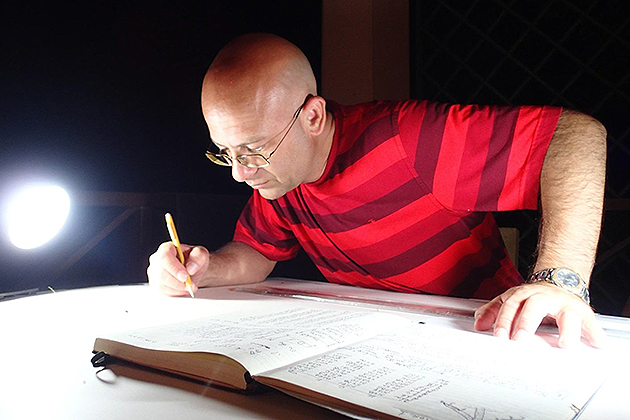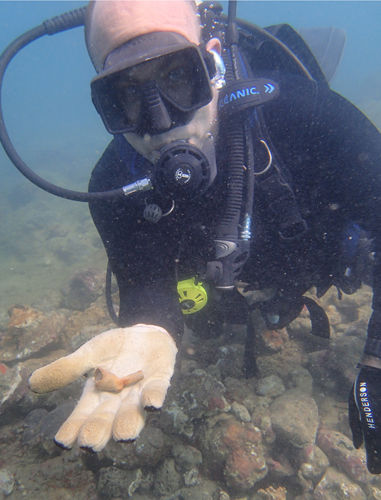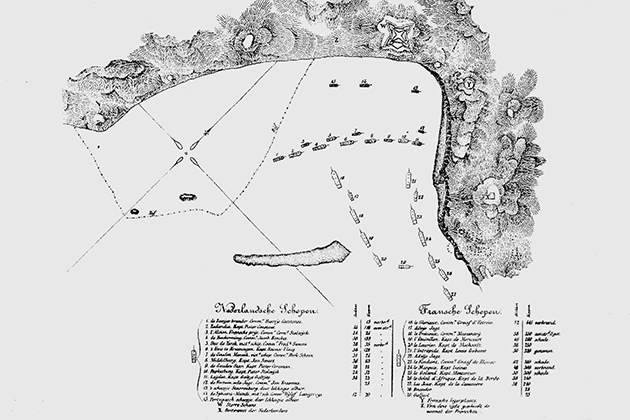Batchvarov, assistant professor of maritime archaeology in UConn's Department of Anthropology, is an internationally known researcher specializing in 17th-century ship building and maritime archaeology. He is leading a multi-phased investigation to find and study the remains of 16 vessels that were sunk in a fierce battle that took place in what is now known as Scarborough Harbour in the Republic of Trinidad & Tobago.
The battle was fought between the invading French and the Dutch, who controlled the island of Tobago at that time. Although often overlooked by students of maritime history, the confrontation was significant, both in terms of the number of lives lost and the damage done to both fleets.
"What has been discovered is a treasure trove for archaeological researchers," says Batchvarov.

"To find what we believe to be the Huis de Kreuningen - almost by accident, as she was outside the boundaries where we expected to find her - undiscovered and untouched for over 300 years was an exciting moment," Batchvarov says.
His research team went on to survey and map the wreck over the summer.
The find is a significant source of information for the maritime history of the period. "Although we have some written records of the battle itself, we possess no detailed plans of 17th-century warships," Batchvarov says, "so our only sources of information about the ships of the day are the wrecks themselves. It isn't overstatement to say that what has been discovered is a treasure trove for archaeological researchers."
What is known about the battle is that all told, 2,000 people, including 250 Dutch women and children and 300 African slaves, were killed. In addition to the Huis de Kreuningen, which was the largest ship in the Dutch fleet, the flagship of French Vice Admiral Comte D'Estrée - the Glorieux - was also sunk and all but 80 of the 450 men aboard were lost. In the end, the Dutch lost more vessels, but they succeeded in repelling the French landing party and retained possession of the island.

The Huis de Kreuningen, though the largest in the Dutch fleet at 39.6 meters in length and 9.62 meters in breadth, was only about three quarters of the size of her French foe, the much newer and better armed Glorieux. With only 56 guns to her opponent's 72, and with a crew of 129 instead of her full complement of 290 sailors aboard, existing records of the battle report that she put up a valiant fight until her captain either cut her anchor cables so she would run aground, or set her afire - accounts vary - in order to avoid capture.
Another benefit of the project is the opportunity it provides for students to participate in Batchvarov's ongoing research. Students enrolled in maritime studies at UConn's Avery Point campus, the only undergraduate program in the country with a maritime archaeology minor, have a singular opportunity.
On this summer's trip to Tobago, Mark Wegiel '15 (CLAS), a former Navy diver, took part in the exploration of the Huis de Kreuningen. With plans for doing graduate work in anthropology with a concentration in maritime archaeology, Wegiel says the dive in Scarborough Harbor gave him a new perspective.
"I had plenty of experience as a diver during my years in the Navy," he says, "but having the chance to take part in surveying and mapping the wreck and being introduced first hand to the techniques of archaeological exploration was something new and exciting. As an undergraduate, I couldn't have gotten this experience anywhere else."
Permission to excavate the shipwrecks in and around Scarborough Harbour has been granted by the Tobago House of Assembly to the Rockley Bay Research Project, which is supported by the University of Connecticut and the Institute of Nautical Archaeology of the United States.
Artifacts and other items found in the shipwrecks are the property of Tobago and will eventually be displayed on the island. Excavation is expected to take three to five years.
In addition to his work in Tobago, Batchvarov is one of the world's leading experts on the Swedish warship, Vasa, which sank in Stockholm Harbor in 1628. He has worked on Ottoman, Greek, and Phoenician ships, and has recently been invited to participate in an international collaboration that will study ships of state from 1300 to 1800. Batchvarov will concentrate on 17th-century shipbuilding technology development. The only person to have successfully excavated a Black Sea shipwreck, he is also involved in an international collaborative study of the Black Sea littoral zone - or shoreline to the high-water mark - that will concentrate on human adaptation to sea changes from the Upper Paleolithic era to the 19th century. The University of Connecticut is the only non-European institution invited to participate in these important endeavors.




Reader Comments
to our Newsletter